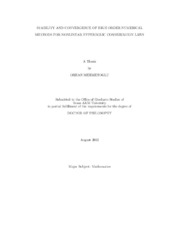| dc.description.abstract | Recently there have been numerous advances in the development of numerical algorithms to solve conservation laws. Even though the analytical theory (existence-uniqueness) is complete in the case of scalar conservation laws, there are many numerically robust methods for which the question of convergence and error estimates are still open. Usually high order schemes are constructed to be Total Variation Diminishing (TVD) which only guarantees convergence of such schemes to a weak solution. The standard approach in proving convergence to the entropy solution is to try to establish cell entropy inequalities. However, this typically requires additional non-homogeneous limitations on the numerical method, which reduces the modified scheme to first order when the mesh is refined. There are only a few results on the convergence which do not impose such limitations and all of them assume some smoothness on the initial data in addition to L^infinity bound.
The Nessyahu-Tadmor (NT) scheme is a typical example of a high order scheme. It is a simple yet robust second order non-oscillatory scheme, which relies on a non-linear piecewise linear reconstruction. A standard reconstruction choice is based on the so-called minmod limiter which gives a maximum principle for the scheme. Unfortunately, this limiter reduces the reconstruction to first order at local extrema. Numerical evidence suggests that this limitation is not necessary. By using MAPR-like limiters, one can allow local nonlinear reconstructions which do not reduce to first order at local extrema. However, use of such limiters requires a new approach when trying to prove a maximum principle for the scheme. It is also well known that the NT scheme does not satisfy the so-called strict cell entropy inequalities, which is the main difficulty in proving convergence to the entropy solution.
In this work, the NT scheme with MAPR-like limiters is considered. A maximum principle result for a conservation law with any Lipschitz flux and also with any k-monotone flux is proven. Using this result it is also proven that in the case of strictly convex flux, the NT scheme with a properly selected MAPR-like limiter satisfies an one-sided Lipschitz stability estimate. As a result, convergence to the unique entropy solution when the initial data satisfies the so-called one-sided Lipschitz condition is obtained. Finally, compensated compactness arguments are employed to prove that for any bounded initial data, the NT scheme based on a MAPR-like limiter converges strongly on compact sets to the unique entropy solution of the conservation law with a strictly convex flux. | en |


